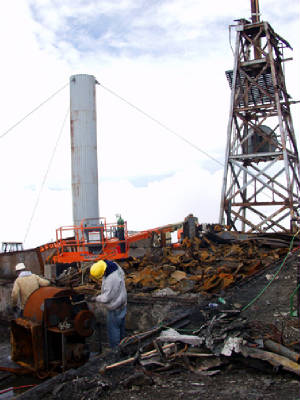|

THOMPSON AND MESERVES PURCHASE - Tom Leger lamented yesterday morning that after nearly two weeks of working at the summit
of Mount Washington, he’s more waterlogged than sun-tanned. "I think I’ve seen the sun for about
30 minutes in all that time," he said. But a few minutes later, in a way weather only on top of the 6,288-foot
summit can, one last bank of fog found another peak to roll across and the visibility cleared from about 50 feet to five miles.
"Make that 35 minutes," he said, before clouds wrapped themselves around the summit again a few moments later.
There was little time for Leger, who, with Jason Farrell, owns Raymond-based Dem-Con, to enjoy the weather break. For nearly
two weeks, a four-man crew has been on the summit of the Northeast’s highest mountain, clearing the pile of debris,
which is all that remains of the generator building that burned last February.

Twisted and broken, charred and fused, the remnants of the building, which was a communications nerve center for public
safety agencies and commercial broadcasters in northern New England, are undergoing one last demolition. The Dem-Con crew
has spent the past 12 days using blow torches to cut apart and then separate the various metal and other debris.
A month ago, the Governor and Council approved a $186,500 contract with Portsmouth-based Ricci Construction to
remove the remains of the generator building. Ricci, in turn, sub-contracted Dem-Con for the demolition. Leger’s demolition
credits include overseeing the wrecking of Malden Mills after the devastating fire there and the old Boston Garden.
"It took two and a half months to set this up - the dynamics and logistics," Leger said. "It would be a simple
project at ground level - we’d be out three or four days if this was at ground level. Up here, we’re dealing with
Mother Nature - you have to work with her."
And since the beginning of the project, Mother Nature has been sparing with her nice summer days. Mount Washington
isn’t known for having the world’s worst weather for nothing.
"You have to work around the weather and the road conditions," Leger said. Part of the logistics he had
to plan for included just how to get the debris, once its cut up into manageable pieces, off the mountain. He looked at the
cost of hiring a helicopter, but, he said, "That costs more than some people make in a year."
So, the debris comes down the 8-mile Mount Washington Auto Road. But because this is one of the region’s top tourists
attractions, Leger’s crew can only haul it down between 7:30 pm and 7:30 am.
Terry Corrigan of Randolph operates a backhoe during the day and at night, he makes the hour-long trip down
from the Rock Pile. He’s no stranger to the top of the mountain; he’s done constructions projects there before,
as have his father and grandfather before him.
"You have to know where the road is," he said. "A lot of times, you can’t see it - you have to look
out the side window and look for the white lines." Because of the road’s dips and sharp turns, Corrigan
can’t use a flatbed, so the debris comes down on a dump truck. Depending on the weather, he can sometimes get two trips
in a night. Top speed is 8 to 10 mph.
On a break yesterday morning, Farrell, his father, Wes, and Jaime Doherty went into the Sherman Adams building
for a hot cup of coffee. They were all soaking wet.
"In the process of gearing up for this job, I did my homework and asked for cold weather gear," Leger said.
"One of my suppliers thought I was retarded." At the top of the mountain, where the temperature was 54 with a 21 mph wind
in thick clouds yesterday, is a supply of insulated gloves, hoods and hard hat straps; glasses, goggles and orange vests to
keep everyone visible when the fog turns everything sheet-white.
Still, Jason Farrell eschewed a bright yellow rainsuit, saving it for the ride down later last night.
"It helps for a little while, but then the rain just drives right through you," he said.
Leger estimates it will take another week and half before the remains of the generator house are fully off
the mountain. It will take an estimated 30 trips to bring it all down, where it is then brought for recycling.
In the meantime, the crew will carry on in the midst of whatever Leger’s friend throws their way.
"It’s mind-boggling to the point where you try to think of everything you may need, but Mother Nature
always throws you a curve," he said.

|



